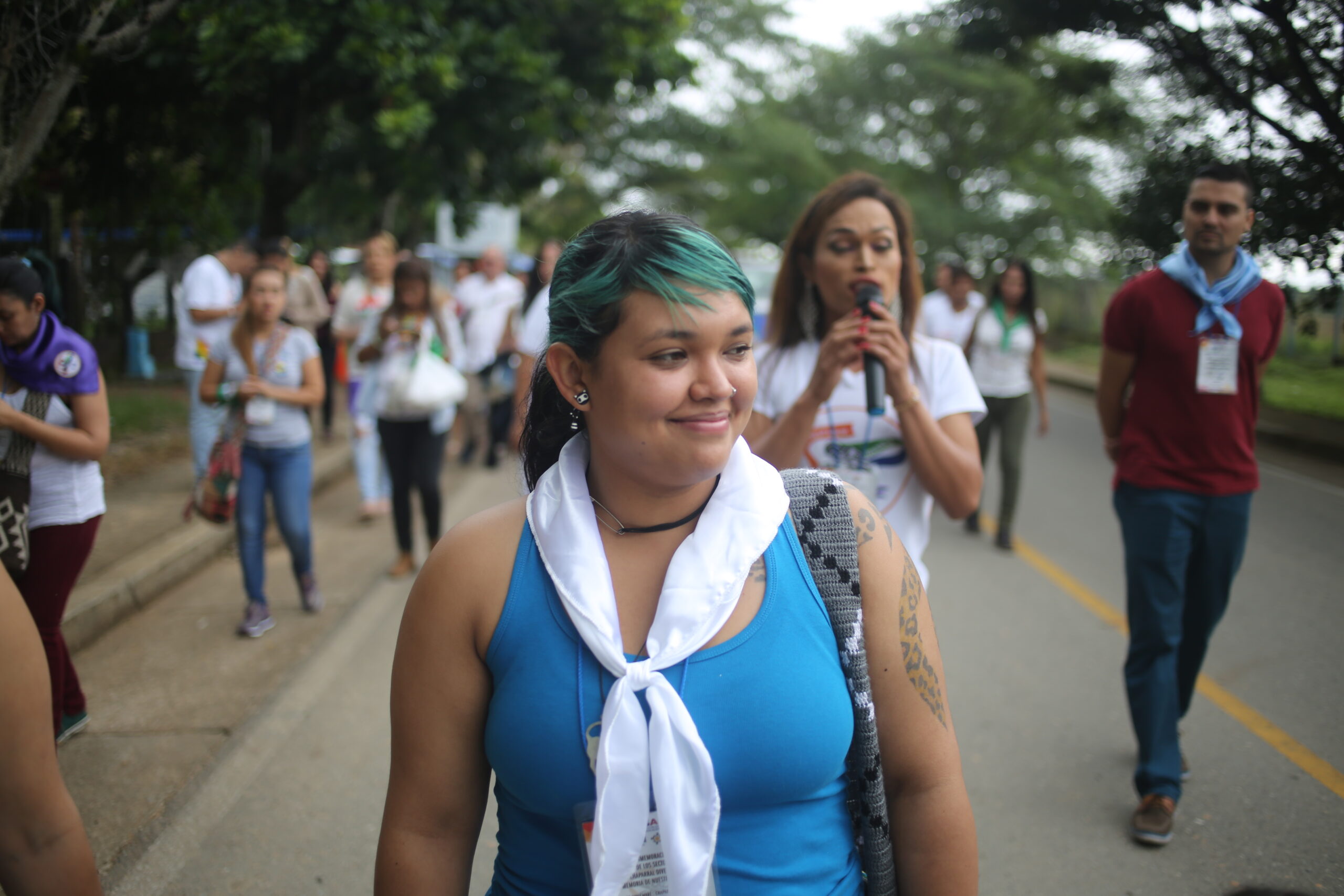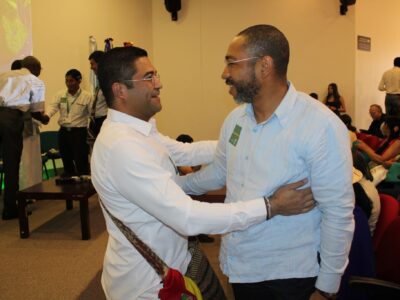
Social and Behavior Change (SBC) is the process of understanding why people behave in certain ways and developing approaches to influence shifts in those behaviors and the contextual social structures to have positive impacts on health, the environment, and other aspects of well-being.
Many of the foundational approaches to behavior change were developed around improving health, such as visiting a clinic during pregnancy, handwashing, and reducing substance abuse. However, there is a growing interest in applying SBC principles and approaches to a diverse array of sectors, including agriculture and food production, business and entrepreneurship, financial decision-making, and community governance and peacebuilding. As a technical director at ACDI/VOCA, I recently attended the International Social and Behavior Change Communication (SBCC) Summit in Morocco, where I had the opportunity to learn from leading SBC experts as well as present ways ACDI/VOCA has been applying SBC approaches to complex market systems challenges. Throughout this conference, it became clear that while SBC has many exciting frontiers, there is a need to emphasize core guiding principles to SBC work that must not be lost in translation.
Achieving Change Through Locally Led Development
Localization is one such core principle. Local partners leading the way is an opportunity to not only ensure a more equitable and inclusive distribution of power, in line with USAID’s commitments to localization, but also to find solutions that are more effective, sustainable, and adaptable to the systemic changes that can occur over the course of an SBC activity.
Ultimately, SBC practitioners must understand that trying to “make” people change their behavior is not only ineffective for creating deep and sustainable changes, but also potentially dangerous if practitioners don’t understand the nuance and complexities of a context. These nuances include risk factors for gender-based violence, social norms that hinder access to community resources, and power imbalances across gender, age, and social identity.
When SBC approaches are localized in a way that incorporates inclusive principles and elevates the voices of vulnerable groups throughout the design process, these risks are more likely to be mitigated. Those most at-risk of exclusion are empowered to define safe approaches to change in their community. For example, ACDI/VOCA developed the DecidoSer (“I Choose to Be”) psychosocial methodology under the Program of Alliances for Reconciliation, funded by USAID. This methodology was designed to aid peace and reconciliation in communities and families following years of civil conflict in Colombia. Rather than training participants on a pre-defined curriculum or disseminating static messages, DecidoSer creates expert-facilitated safe spaces for community members to lead conversations and express their identities in ways they are most comfortable with. Through this process, communities have experienced transformative shifts in social norms, where youth, LGBTQI+ individuals, and indigenous groups have found increased social cohesion, lower levels of violence, and more freedom of self-expression in their communities.

Analyzing Systems That Influence Behaviors
Positioning local actors to lead is core to ACDI/VOCA’s facilitative approaches to SBC for improved nutrition and gender, youth, and social inclusion in the context of market and food systems development. ACDI/VOCA’s expertise in systems change is well suited to understanding the complexities and nuances of social systems and human behaviors. We adapt and apply our suite of systems diagnostics tools to engage diverse perspectives, reflecting a core belief that making sense of a system is not just the domain of outside experts, but rather requires the insider perspectives and knowledge that only local actors can provide.
Frameworks such as USAID’s 5Rs provide a roadmap for understanding the factors that influence a social system. Analytical tools, such as Social Network Analysis and Private Sector Landscape Mapping, help contextualize the environment in which individuals and institutions make decisions. Throughout this process, we prioritize opportunities to build local leadership in the analysis, design, and evaluation of interventions to catalyze SBC.
How do we put the localization of SBC into practice? From our experience, it can take many forms:
- Facilitate access to SBC skills.
Connecting grassroots organizations, small businesses, and local change agents with the evidence-based skills, knowledge, networks, and tools they need allows them to identify critical challenges, innovate effective solutions, and, ideally, define success toward shifting the behaviors and social norms of their own community. Building local SBC capacity is a core strategy for Tanager’s IGNITE project, which is empowering local service providers to support African agricultural institutions in using SBC principles and approaches to promote improved gender norms and nutrition.
- Engage institutions for change.
Byleveraging our convening power as USAID implementing partners together with the networks and contextual understanding of our local partners, we can bring socially influential institutions and vulnerable populations together. This allows us to build mutual understanding of challenges and map out strategies to shift harmful social norms. For example, through the Victory Against Malnutrition Plus Activity, funded by USAID in Burkina Faso and implemented by ACDI/VOCA, 183 religious leaders led ongoing community discussions on faith-based promotion of gender equality.
- Elevate marginalized voices.
Groups that suffer from social exclusion and marginalization often have the most accurate perspective on the power structures that restrict their access to resources and services. As such, they have critical insights for activities to catalyze change. Through the Feed the Future Bangladesh Livestock Production for Improved Nutrition Activity, funded by USAID and implemented by ACDI/VOCA, dialogues with women revealed that men had significant power over household consumption choices and were strongly influenced by religious leaders. Engaging imams to share and promote good nutrition practices created an enabling environment where women were able to put into practice the training they had received on dairy consumption.
- Articulate the business case.
By gathering and communicating data and evidence to demonstrate to policymakers and local food businesses the long-term benefits of social business strategies that facilitate behavior change, we can create sustainable incentives for continuing these activities after a project ends. Such strategies may include improving packaging in response to customer demand, promoting the nutritious qualities of food, or engaging women and youth as entrepreneurs, employees, and customers. Articulating the business case for such strategies was important for increasing awareness among large processor businesses of the potential demand for pulses and zinc-biofortified rice under the Feed the Future Bangladesh Rice and Diversified Crops Activity, funded by USAID and implemented by ACDI/VOCA. Its televised NutriChamps cooking competition was popular among youth audiences and demonstrated the untapped market for nutritious, healthy food.
- Strengthen communication and marketing skills.
By leading trainings that build the capacity of business service providers, creative agencies, and entrepreneurs to use innovative messaging design strategies, we can aid in increasing consumer demand for nutritious and climate-smart food, hygiene and clean water products, and other products that improve health.
For example, the Feed the Future Tanzania NAFAKA II Activity, funded by USAID and implemented by ACDI/VOCA, partnered with local millers to introduce maize flour fortification technology. The team trained millers to reach consumers with persuasive messaging about the health benefits of fortified flour. To instill local capacity for leading this type of work after the activity ended, lessons from the partnership and other learnings from stakeholder dialogues were captured in a handbook on how to design effective SBC strategies to promote fortification at local and regional levels.
Transferring Power
Social norms and human behaviors lie at the heart of many of the greatest challenges to improved nutrition, female empowerment, and social inclusion. By using strategies such as these to empower local actors to catalyze change, we can put power in the hands of those closest to these challenges, resulting in more sustainable and inclusive development.
Comments








